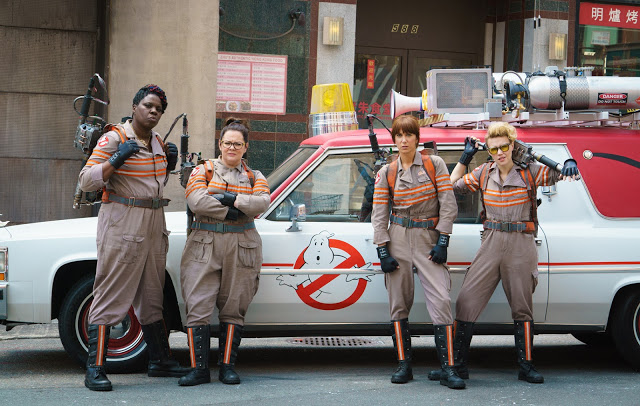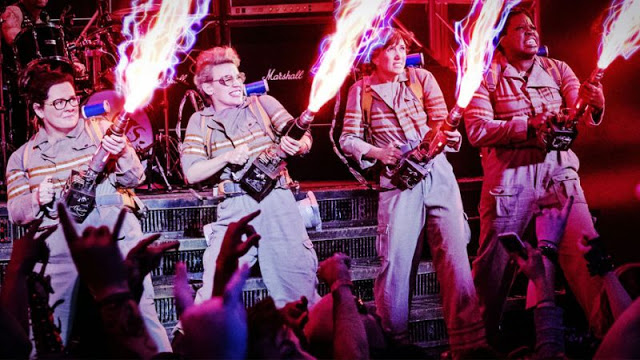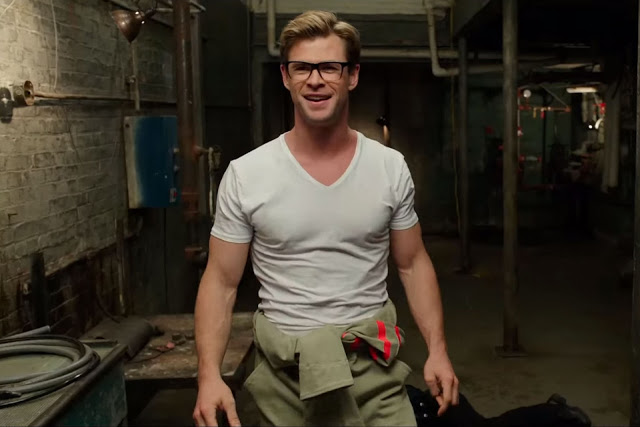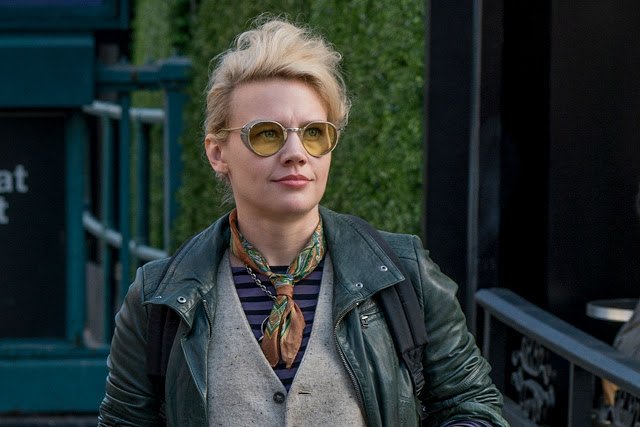Can women be funny? Is Chris Hemsworth just a pretty face with an accent? Should fans of a beloved classic feel rightfully outraged when it’s remade featuring members of a different sex? The answers to these questions are so obvious—for the record, they are “yes,” “no,” and “are-you-serious-just-shut-the-fuck-up”—that we hardly needed a reboot of Ghostbusters to answer them. But perhaps this loose, breezy new film, which arrives in the polarized age of the hot take and the down-vote, can still teach us something, something beyond the seemingly hard-to-grasp axiom of “don’t judge a movie before you actually watch it”. If there’s a lesson to be learned here, it’s that action-comedies are advised to focus on the comedy rather than the action. When the heroes of this revamped Ghostbusters (directed by Paul Feig from a script he co-wrote with Katie Dippold) are stuck in the lab, trapped in the subway, or confined in any other location where they can joke, whine, titter, and bicker, this movie is a blast. When they’re actually busting ghosts, it’s a snooze.
Thankfully, the proton guns and laser rays stay hidden for most of the film’s first half, allowing Feig to unhurriedly assemble his team of all-star comediennes. Naturally, this begins with Melissa McCarthy, Feig’s regular lead who shot to fame (and an Oscar nomination) five years ago in Bridesmaids and last year delivered a career-best performance in the underrated Spy. (When the Golden Globes honor McCarthy 30 years from now, her clip reel had better feature this.) McCarthy plays Abby, an eccentric scientist who has devoted her life to researching the paranormal. She even long ago wrote a book on the topic, the recent publication of which consternates Erin (Kristen Wiig, in her comfort zone), the manuscript’s co-author who is currently up for tenure at an exalted university. (How exalted? When Erin tenders a recommendation letter from a Princeton professor to her dean, he advises her that she obtain a reference from a school that’s a bit more prestigious.) Once a true believer, Erin has spent years trying to distance herself from her collaborations with Abby, so she’s none too pleased that they’ve resurfaced.
This backstory is entirely pointless, but the good news is that Feig understands this thoroughly. He just needs an excuse to put McCarthy and Wiig in the same room, at which point Ghostbusters starts to hum with humor and verve. The two actresses work well as antagonists, Wiig’s natural meekness serving as cannon fodder to be mowed down by McCarthy’s rampant aggression. (Outside of the cast of Veep, McCarthy remains America’s queen of the dyspeptic one-liner.) Here, however, they prove that they can be just as funny when they’re playing nice. That’s crucial, as the fissures in Abby and Erin’s once-cracked friendship are quickly sealed up once they jaunt over to a haunted mansion and witness their first bona fide apparition, which promptly spews gooey slime all over Erin. (As summer 3-D movies go, Ghostbusters makes more inventive and playful use of the format than most, with digital effects bursting right out of the screen; at times, you might wonder if a ghost has just vomited into your popcorn.) That sighting inspires Abby and Erin to set up the titular spectre-smashing organization, which is joined by Patty (Leslie Jones) and Holtzmann (a tremendous Kate McKinnon). Together this quartet resolves to rid New York City of ghosts and—
Wait a minute. There’s something fishy about these characters, a suspicious commonality that renders them markedly different from the heroes of the 1984 original. I’m sure you’ve figured it out: They all have two-syllable names.
Sorry. What I meant to say was that they’re all women, and if you think that’s an unremarkable distinction, then I both envy and pity you, because you’ve somehow avoided the internet for the past half-year. For those of us who possess both Wi-Fi and a semblance of rationality, it’s been a trying last few months. The preemptive online furor that erupted over a ladies-only Ghostbusters is so infantile that it is difficult to reason with. The arguments made by possessive fanboys—essentially, that Feig and his actresses were somehow desecrating the original film by remaking it with characters of a different gender—were absurd, doubly so once you remember that said fanboys issued their harangues months before Feig’s movie was even released. (Even more repugnant: the post-release hate speech directed at Jones on Twitter.) Nevertheless, these sexist gripes inadvertently raised an intriguing question about Feig’s approach to the material. Given the towering shadow cast by Ivan Reitman’s eminently quotable original, can Feig make a movie that simultaneously honors its legacy and stands on its own?
Kind of. Tonally, Feig gets his Ghostbusters just right, mimicking the goofball camaraderie of the precursor while still giving his actresses the space to riff. The problem is the plot. The narrative here follows the same basic trajectory of the ’84 classic, which is a disappointing duplication; as hilarious and quotable as that movie was—I admit that I have said “The flowers are still standing!” and “We came, we saw, we kicked its ass!” more times than a grown man should—its story was hardly its strongest element. Yet perhaps out of a misplaced sense of duty, Feig leads his ladies down the same predictable path: Our ghostbusters are first dismissed, then embraced, then called upon to save New York City (principal photography actually took place in Boston) from a steady escalation of paranormal activity. There are some sly tweaks to the formula—this time, the government suits (led by an amusingly unctuous Andy Garcia as the Big Apple’s mayor) never dispute the veracity of the ghostbusters’ claims but insist that they keep things under wraps for PR purposes—but there’s still a been-there, busted-that feel to the proceedings. (This impression of recycling is only bolstered by the obligatory cameos from the original cast, including Dan Aykroyd, Sigourney Weaver, Ernie Hudson, Annie Potts, the Stay Puft Marshmallow Man, and—as befits his lackluster late period—an unfunny Bill Murray.)
To be fair, it would be difficult to make a film called Ghostbusters that didn’t contain scenes of characters battling phantasms. Yet where Feig displayed superlative command of action-movie vocabulary in Spy, his set pieces here are largely limp. Part of that derives from the incorporeal nature of ghosts, which necessarily robs the film of the tangible weight that’s required to sustain exciting action. But it also stems from the bigger-is-better ethos that has grown to dominate blockbuster filmmaking, an imperative that stands in fundamental opposition to this comedy’s lithe, quirky spirit. The movie’s leaden climax goes on forever, and its length only makes its aesthetic impersonality more glaring. There are a few happy exceptions—Holtzmann receives a terrific hero moment, while a sequence where Erin dives into a vortex achieves a strange, iridescent beauty—but for the most part, it’s a tired recitation of characters randomly firing special effects at other special effects. Bustin’ may make them feel good, but it should have looked better.
Thankfully, Ghostbusters doesn’t rely entirely on computer-aided pyrotechnics in its good-hearted effort to entertain. It’s as much a pleasant hangout movie as a CGI spectacle, and once our featured foursome join forces, they exhibit an enjoyable and natural camaraderie. This is more attributable to the actors than the dialogue. Feig and Dippold’s script has a handful of zingers—my favorite involves Holtzmann referring to Pringles as “salty parabolas”—but the writing here is competent rather than uproarious. That’s still good enough, given the cast Feig’s working with, one that makes room for a beefcake alongside the ladies. Indeed, the casting of Hemsworth as a cheerfully dimwitted receptionist named Kevin proves inspired; the movie gets some of its best laughs from the women reacting in stupefaction to Kevin’s idiocy—watch McCarthy’s face when Kevin matter-of-factly explains that he removed the lenses from his glasses because they kept getting dirty—and Hemsworth, still built like a Greek Norse god, showcases impressive comic range.
But if this new Ghostbusters will be remembered for one thing, it will surely be the cinematic introduction of Kate McKinnon. A Saturday Night Live veteran with a lopsided grin and elastic eyebrows, McKinnon has appeared in a handful of feature films, but she’s never had the opportunity until now to cement her singular presence on the screen. The biggest issue with this reboot is its sense of fidelity and safety, but in imbuing Holtzmann with a streak of anarchic volatility, McKinnon undercuts that placidity at every turn. Whether she’s flashing a mischievous smile in the middle of a shootout or munching on those aforementioned Pringles while eyeing a ghost, you can’t take your eyes off her.
McKinnon’s brilliance aside, Ghostbusters is a curious commodity: a mediocre movie that I nevertheless hope receives a sequel. The talent is clearly in place—Feig and his team just need the freedom to stray from the script and strike out on their own. For now, though, this remake leaves a slightly bitter aftertaste of unrealized potential. It could have been genuinely interesting, but it settles for being pleasant, which is another way of saying dull. I ain’t afraid of no ghosts. I’m just bored by them.
Jeremy Beck is the editor-in-chief of MovieManifesto. He watches more movies and television than he probably should.




